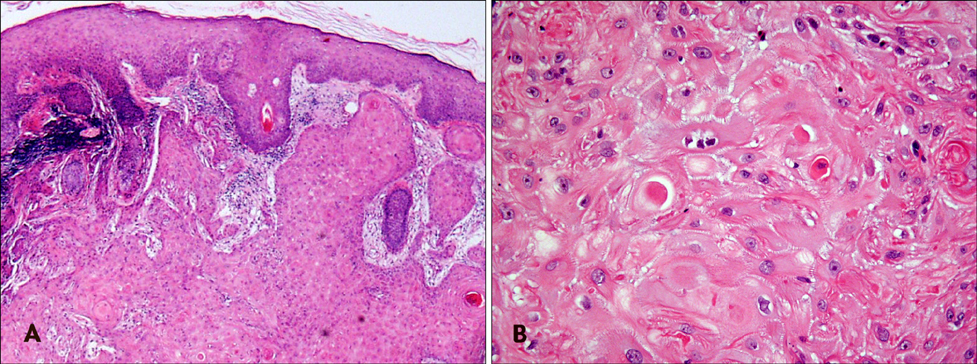Ann Dermatol.
2009 Feb;21(1):81-83. 10.5021/ad.2009.21.1.81.
Squamous Cell Carcinoma Masquerading as Rhinophyma
- Affiliations
-
- 1Department of Dermatology, Kangnam St. Mary's Hospital, College of Medicine, The Catholic University of Korea, Seoul, Korea. knderma@ catholic.ac.kr
- KMID: 2172075
- DOI: http://doi.org/10.5021/ad.2009.21.1.81
Abstract
- A rhinophyma lesion can mask the existence of coexisting occult skin cancers, and many types of tumors can mimic a rhinophyma. Although several coexistent malignant tumors have been reported in patients with rhinophyma, few reports have described the coexistence of rhinophyma and cutaneous squamous cell carcinoma (SCC). Herein, we report on a case of SCC in a 45-year-old man who presented with 2-month-history of a painful, erythematous, globular plaque on the tip of his nose and this lesion mimicked a rhinophyma lesion. The histopathologic examination showed a proliferation of atypical squamous cells that extended into the dermis, which was consistent with SCC. He was treated with surgical excision, and there has been no evidence of recurrence during the follow-up period of 1 year.
Keyword
MeSH Terms
Figure
Reference
-
1. James WD, Berger TG, Elston DM. Andrews' diseases of the skin: clinical dermatology. 2006. 10th ed. Philadelphia: Saunders Elsevier;245–248.2. Pelle MT. Wolff K, Goldsmith LA, Katz SI, Gilchrest BA, Paller AS, Leffell DJ, editors. Rosacea. Fitzpatrick's dermatology in general medicine. 2008. 7th ed. New York: McGraw-Hill;703–708.3. Lutz ME, Otley CC. Rhinophyma and coexisting occult skin cancers. Dermatol Surg. 2001. 27:201–202.
Article4. Wende GW, Bentz CA. Rhinophyma: a pathological analysis of five separate tumors occurring in the same patient. J Cutan Dis. 1904. 22:447–460.5. McKenna DJ, McKenna K. Basal cell carcinoma lurking within gross rhinophyma. Clin Exp Dermatol. 2006. 31:173–174.
Article6. Aguila LI, Sanchez JL. Angiosarcoma of the face resembling rhinophyma. J Am Acad Dermatol. 2003. 49:530–531.
Article7. Broadbent NR, Cort DF. Squamous carcinoma in longstanding rhinophyma. Br J Plast Surg. 1977. 30:308–309.
Article8. Kornblut AD, Evers K. Rhinophyma and intranasal carcinoma. J Laryngol Otol. 1973. 87:1137–1141.
Article9. Ross DA, Davies MP. Squamous cell carcinoma arising in rhinophyma. J R Soc Med. 1992. 85:236–237.10. Motley RJ, Douglas-Jones AF, Holt PJ. Sebaceous carcinoma: an unusual cause of a rapidly enlarging rhinophyma. Br J Dermatol. 1991. 124:283–284.
Article11. Acker DW, Helwig EB. Rhinophyma with carcinoma. Arch Dermatol. 1967. 95:250–254.
Article12. Lee JB, Lee SC, Won YH, Chun IK. Clinical and histopathological observation of cutaneous squamous cell carcinoma over 10 years from 1985 to 1994. Korean J Dermatol. 1996. 34:775–783.13. Jang KA, Lee WS, Choi JH, Sung KJ, Moon KC, Koh JK. A clinico-pathological study of squamous cell carcinoma. Korean J Dermatol. 2001. 39:7–15.14. Kim YD, Suhr KB, Lee JH, Park JK. A clinical and histopathological study of cutaneous squamous cell carcinoma. Korean J Dermatol. 2002. 40:25–30.15. Conley J. Cancer of the skin of the nose. Ann Otol Rhinol Laryngol. 1974. 83:2–8.
Article16. Roush GC. Epidemiology of cancer of the nose and paranasal sinuses: current concepts. Head Neck Surg. 1979. 2:3–11.
Article17. Grossman D, Leffell DJ. Wolff K, Goldsmith LA, Katz SI, Gilchrest BA, Paller AS, Leffell DJ, editors. Squamous cell carcinoma. Fitzpatrick's dermatology in general medicine. 2008. 7th ed. New York: McGraw-Hill;1028–1035.



